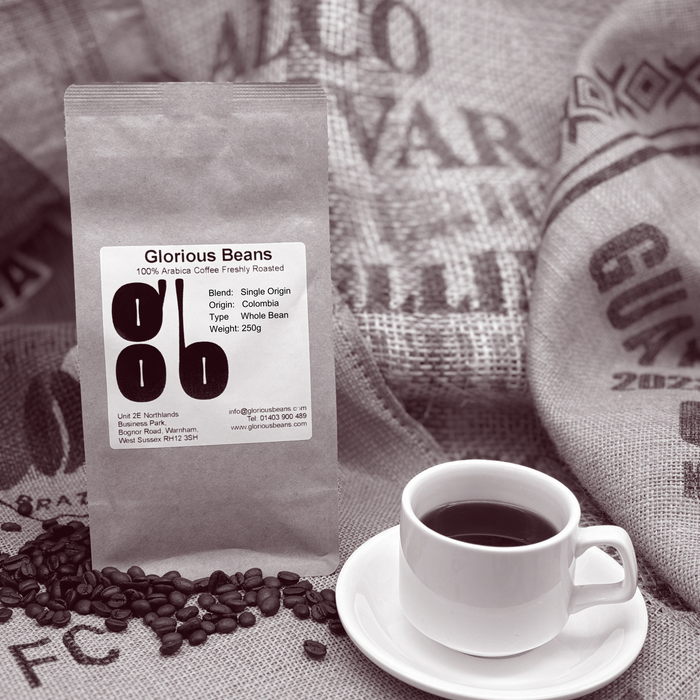A Guide Before Buying SOE Single Origin Espresso
A Guide Before Buying SOE Single Origin Espresso
Blog Article
Coffee Beans Uncovered: Finding the Secrets of Coffee and Blended Coffee Beans
When you consider coffee, what comes to mind? Is it the abundant aroma of coffee or the complexity of a well-crafted blend? Comprehending the subtleties of coffee beans can change your experience. Each range, from Arabica to Robusta, holds its own tricks. As you discover further, you'll reveal just how these beans shape tastes and influence sustainability. What might you uncover regarding your following mug?
The Origins of Espresso: A Historic Perspective
Although espresso is now a staple in coffee society worldwide, its beginnings trace back to the early 20th century in Italy. You may be stunned to learn that the development of espresso was driven by a desire for speed and effectiveness. In 1901, Luigi Bezzera patented the very first coffee machine, aiming to brew coffee faster than typical techniques. This advancement quickly caught the attention of Italian coffee drinkers, bring about the espresso bars we recognize with today.
Understanding Coffee Beans: Qualities and varieties
When you consider espresso, it's important to identify the various bean ranges and their distinct flavors. Each kind brings a distinctive character to your mug, affected by factors like roast levels. Understanding these elements can raise your coffee experience significantly.
Coffee Bean Varieties
As you check out the globe of coffee, you'll swiftly uncover that not all beans are developed equal; each range brings its very own one-of-a-kind tastes and attributes to your mug. One of the most prominent types include Arabica and Robusta. Arabica beans are understood for their smooth, nuanced flavors and lower high levels of caffeine web content, making them a favored amongst coffee connoisseurs. On the other hand, Robusta beans load a more powerful punch with higher caffeine and an extra bitter taste, typically preferred in blends for their crema-enhancing high qualities. You could likewise run into specialty beans like Liberica and Excelsa, which use distinctive accounts and are less common. Each variety offers something various, so experimenting will certainly assist you discover your ideal coffee.
Taste Profiles Discussed
Understanding the taste accounts of various espresso beans can boost your coffee experience. Each bean range uses unique attributes that affect preference, aroma, and mouthfeel. For example, Arabica beans frequently present a sweeter, extra intricate taste with hints of fruit and flower notes, while Robusta beans have a tendency to be bolder, with natural and nutty touches.
When you check out single-origin beans, you may discover distinct regional flavors-- Main American beans may be citrusy and intense, whereas Italian blends frequently provide abundant, chocolatey notes.
Roast Degrees Impact
Roast levels play a vital function fit the taste and aroma of espresso beans, influencing your general coffee experience. With light roasts, you'll uncover intense level of acidity and extra obvious fruity notes. As you move to tool roasts, you'll delight in a well balanced account that showcases sweet taste and intricacy. Dark roasts, on the various other hand, often existing abundant, bold flavors with a smoky coating, however they can mask the beans' inherent qualities. Comprehending these roast degrees aids you select the espresso that fits your taste preferences. Experimenting with various roasts can cause fascinating discoveries, improving your recognition for coffee. So, do not think twice to discover various roast levels and locate your ideal cup!
The Art of Mixing: What Makes Blended Coffee Distinct
What makes blended coffee so interesting? You can experiment with various combinations to improve body, sweetness, and level of acidity, resulting in a mixture that's richer and a lot more complex than a single-origin coffee.
Blending likewise permits you to satisfy varied preference choices. You can craft a blend that's smooth and smooth or one that's bold and durable, relying on your audience. And also, blending can aid preserve uniformity, supplying a dependable flavor experience despite seasonal variants in beans. So, whether you're a home or a barista brewer, understanding the art of blending opens up a globe of creative thinking and flavor possibilities, making your coffee experience genuinely unique - SOE.
Taste Profiles: Sampling Notes of Coffee vs. Blended Coffee
Combined coffee provides a world of taste possibilities, yet when it concerns coffee, you're taking a look at an extra focused experience. Coffee usually showcases bold, abundant tastes with a thicker mouthfeel. You might see notes of dark delicious chocolate, caramel, or also hints of fruit, depending on the beans. The strength can be both invigorating and satisfying.
On the other hand, blended coffee presents an intricate tapestry of flavors. You can explore a variety of tasting notes, from wonderful and nutty to floral and fruity. Each blend can use something distinct, typically integrating beans from various areas to develop a balanced account.
While coffee supplies a strike, combined coffee welcomes you to appreciate the nuances. Whether you choose the robust strength of espresso or the detailed tastes of blended coffee, each cup informs its very own tale, waiting for you to uncover.
Brewing Techniques: Developing Your Espresso Shot
To achieve the ideal coffee shot, comprehending the brewing strategies is essential, as even minor adjustments can significantly influence the flavor and high quality. Beginning by utilizing fresh, high-grade coffee beans; grind them just before brewing for maximum flavor. Go important link for a fine grind, concerning the consistency of common salt, to ensure optimal removal.
Following, take notice of your water temperature level; it needs to be in between 195 ° F to 205 ° F. Too also cold or warm can destroy your shot. Usage concerning 18-20 grams of coffee for a dual shot, and tamp it evenly with strong pressure to create an uniform puck.
Ultimately, regulate your removal time; go for 25-30 seconds. A longer removal can result in resentment, while as well brief can lead to sour flavors. Exercise these techniques consistently, and you'll fine-tune your abilities, accomplishing that rich, robust coffee shot you yearn for. Enjoy the trip!
The Role of Roast Degrees in Espresso and Blended Coffee
After grasping the brewing techniques for espresso, it's time to contemplate just how roast levels affect the taste profile of your coffee. The roast level can significantly change your espresso's body, preference, and scent. Light roasts often tend to highlight the coffee's beginning, offering brilliant level of acidity and fruity notes, while medium roasts equilibrium acidity and sweetness, developing an all-round flavor. Dark roasts, on the other hand, highlight bold, abundant tastes with lower acidity, commonly creating delicious chocolate or great smoky undertones.

Exploring Sustainability: Moral Sourcing of Coffee Beans
When you choose coffee, you're not simply picking a taste; you're deciding regarding the influence on farmers and the environment. Comprehending Fair Profession practices, natural farming techniques, and certification requirements can aid you support sustainable coffee sourcing. Let's explore how these aspects add to an extra honest coffee experience.
Fair Trade Practices
Fair Profession techniques play a crucial role in guaranteeing that coffee beans are sourced ethically and sustainably. When you select Fair Trade coffee, you sustain farmers who obtain fair wages and work in secure problems. By deciding for Fair Trade brands, you're not just enjoying an abundant cup of coffee; you're making a positive impact on the lives of those that grow it.
Organic Farming Approaches
As you discover the globe of honest coffee sourcing, chemical-free farming techniques become an important part of sustainability. By selecting organic coffee, you support techniques that prioritize soil health and wellness, biodiversity, and natural ecological communities. Farmers stay clear of synthetic pesticides and plant foods, relying rather on all-natural compost and crop rotation to enhance dirt fertility. This not just shields the atmosphere however likewise enhances the top quality of the coffee you appreciate. Natural farming urges regional wild animals and promotes a well balanced ecosystem, minimizing the opportunities of illness and pests. Additionally, it often results in stronger, much healthier coffee plants, resulting in richer tastes in your cup. You're making a mindful option that benefits both the world and your palate. when you choose for natural coffee.
Accreditation Standards Explained
Comprehending accreditation criteria is important for anybody thinking about morally sourced coffee. These standards, such as Fair Profession, Rainforest Partnership, and USDA Organic, warranty that coffee is expanded under sustainable practices. When you pick licensed coffee, you sustain farmers that abide by honest labor practices and ecological defense.
Fair Profession qualification focuses on providing reasonable salaries and working problems, while Jungle Partnership emphasizes biodiversity and ecological community preservation. Following time you're at your local coffee shop or grocery store, look for these labels, and really feel excellent knowing your coffee acquisition positively affects communities and the environment.
Frequently Asked Questions


Just How Does Elevation Influence the Growth of Coffee Beans?
Elevation effects coffee bean development by affecting temperature level and environment. Higher elevations frequently generate denser beans with even more complex flavors, while reduced elevations can cause faster growth however less tasty outcomes. You'll taste the difference!
What's the Distinction In Between Arabica and Robusta Beans?
Arabica beans are sweeter and extra complicated, while Robusta beans have a stronger, harsher flavor with higher caffeine material. You'll locate Arabica favored for specialty coffees, whereas Robusta's typically made use of in instant coffee and espresso blends.
Can Coffee Beans Spoil or Lose Flavor In Time?
Yes, coffee beans can go bad and shed flavor gradually. They'll end up being stale if you save them poorly or maintain them also my latest blog post long. Constantly keep your beans in a closed container far from light and moisture.
What Are the Wellness Benefits of Drinking Espresso?
Drinking coffee boosts your power, boosts psychological clearness, and may reduce the danger of specific conditions. It's rich in antioxidants, supports metabolic rate, and can boost mood, making it a helpful selection for your everyday regimen.
How Does Water Top Quality Influence Espresso Extraction?
Water high quality substantially influences espresso removal. It impacts the solubility of oils and tastes, affecting preference and scent. Using filtered water can improve your espresso, making certain a pleasurable and well balanced cup every time you her latest blog make.
Coffee Beans Uncovered: Discovering the Secrets of Espresso and Blended Coffee Beans.
Understanding the flavor profiles of different espresso beans can boost your coffee experience.Roast degrees play an important duty in shaping the taste and fragrance of coffee beans, influencing your general coffee experience (SOE).Blended coffee provides a globe of taste opportunities, however when it comes to coffee, you're looking at a more concentrated experience.After understanding the developing methods for espresso, it's time to consider just how roast levels affect the taste profile of your coffee
Report this page